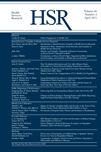Patient-Centered Care Categorization of U.S. Health Care Expenditures
Abstract
Objective. To categorize national medical expenditures into patient-centered categories.
Data Sources. The 2007 Medical Expenditure Panel Survey (MEPS), a nationally representative annual survey of the civilian noninstitutionalized population.
Study Design. Descriptive statistics categorizing expenditures into seven patient-centered care categories: chronic conditions, acute illness, trauma/injury or poisoning, dental, pregnancy/birth-related, routine preventative health care, and other.
Data Collection Methods. MEPS cohort.
Principal Findings. Nearly half of expenditures were for chronic conditions. The remaining expenditures were as follows: acute illness (25 percent), trauma/poisoning (8 percent), dental (7 percent), routine preventative health care (6 percent), pregnancy/birth-related (4 percent), and other (3 percent). Hospital-based expenditures accounted for the majority for acute illness, trauma/injury, and pregnancy/birth and over a third for chronic conditions.
Conclusions. This patient-centered viewpoint may complement other methods to examine health care expenditures and may better represent how patients interact with the health care system and expend resources.




